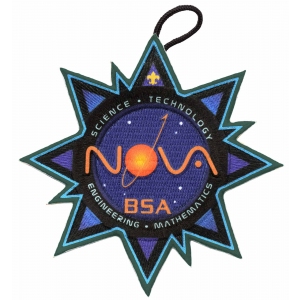|
|
Become A Sponsor
|
Why Ads

Wade!
Nova
Award
for Venturers and Sea Scouts
The Requirements were
ISSUED effective
June 2018.
This module is designed to help you explore how water
affects your life every day. Wade is part of the Science category.
- Choose A, or B, or C and complete ALL the requirements:
- Watch about three hours total of science-related programming that
discusses water as it relates to the hydrologic cycle, primary sources,
primary users (including wildlife), health, sources of pollution, waste
treatment, and related sciences and technologies. Then do the following:
- Make a list of at least five questions or ideas from the show(s)
you watched.
- Discuss two of the questions or ideas with your counselor.
| Some examples include - but are not limited to - shows found
on PBS (" NOVA"), Discovery Channel, Science Channel, National
Geographic Channel, TED Talks (online videos), History Channel,
the National Academy of Sciences YouTube Channel, and
www.waterblues.org.
You may choose to watch a live performance or movie developed
by a local museum or state or federal agency. You may watch
online productions with your counselor's approval and under
your parent's supervision. |
- Read (for about three hours total) about water as it relates to
the hydrologic cycle, primary sources, primary users, health, sources
of pollution, waste treatment, and related sciences and technologies.
Then do the following:
- Make a list of at least five questions or ideas from each article.
- Discuss two of the questions or ideas with your counselor.
| Examples of magazines include - but are not limited to -
Odyssey, Popular Science, Science Illustrated, Natural History,
Scientific American, Nature Conservancy, Sage Magazine, Smithsonian,
National Geographic, LakeLine, and WaterWorld. |
- Do a combination of reading and watching (about three hours total).
Then do the following:
- Make a list of at least five questions or ideas from each article
or show.
- Discuss two of the questions or ideas with your counselor.
- Choose ONE STEM field of interest from the following list. Complete
ALL the requirements for a Venturing STEM exploration in that field. You
should be prepared to discuss the role of water in the area or field you've
chosen. (If you have already completed a Venturing STEM exploration in one
of these fields, please choose a different field for this award.)
| |
Chemistry |
Nature |
| |
Environmental Science |
Oceanography |
| |
Fish and Wildlife Management |
Public Health |
| |
Fishing |
Soil and Water Conservation |
| |
Fly-Fishing |
Sustainability |
| |
Forestry |
Weather |
| |
Geology |
- Learn how the volume of water changes as it moves from phase to phase.
Do all of the following.
- Describe how you would measure the change in volume for the transition
of water from liquid to ice.
- Discuss with your counselor the effects that floating sea ice and
land-based ice have on sea levels when they melt.
- Discuss with your counselor the effects that floating sea ice and
land-based ice have on water tables when they melt.
- Prepare two demonstrations of surfactants and present them to a group
of Cub Scouts or other youth. Make sure to explain the science involved
and how surfactants can be used in oil spill cleanup and recovery. Explain
to your counselor the physical concept(s) involved.
- Water, wetlands, and wildlife. Do ONE of the following options (A or
B).
- Identify and locate on a map the five largest bodies of water near
where you live, and indicate the water flow for each. These could be
creeks, streams, rivers, bayous, lakes, bays, estuaries, or oceans.
The flow should culminate in the largest water body in your area.
- Identify 10 of the common invertebrates and vertebrates that
are probably present in these different bodies of water. Learn what
a bioindicator is, and identify any in your system. You may choose
to contact a local biology teacher, college professor, nature center
naturalist, or state fish and wildlife expert, or you can use resources
from your local conservation department.
- Research the services that wetlands perform for water quality,
flood control, and wildlife habitat. How can wetlands be used to
complement sewage treatment plants? Discuss your findings with your
counselor.
- Surface water
- Discuss with your counselor the following concepts: a watershed
and how it relates to a river basin, runoff, runoff coefficient,
infiltration, point source pollution, non-point source pollution,
and oceanic dead zones near the mouth of rivers.
- Determine which river basin you live in and research (or estimate)
its size. Estimate the total volume of water that falls on this
watershed every minute during a 1-inch per hour rainfall.
- Construct a chart that shows the volume of water that runs into
the river as a fraction of the total rain falling on the watershed
(using composite runoff coefficients). Estimate the rate of runoff
in cubic feet per minute for a 1-inch per hour rainfall from your
home's lot or a nearby property.
- Discuss with your counselor the implications of these calculations
as they relate to the effect of changes in land use on flooding,
soil moisture, erosion, and point and non-point source pollution.
What are the most common types of water pollution in your area,
and how are these being impacted by land use? How might these be
reduced?
- Choose ONE of the following options:
- Research a disaster involving water, such as the receding Sarichef
Island in Alaska, the 2011 Tōhoku tsunami, a hurricane, coral reef bleaching,
sea level rise, etc. Determine the causes of the event, the damage caused,
and how the area has recovered. Find out about any remediation that
has occurred to restore the area to its pre-disaster state or efforts
to prevent future damage from similar events. Share the results of your
research with your crew and with your counselor.
- Research the major functions of a sewage treatment plant. Describe
to your counselor how it reduces the impact of sewage on aquatic life.
List any pollutants that remain in the water after processing and their
potential impact on aquatic life.
- Visit a place where water is being processed either by man or by
nature (wastewater treatment plant, naturalist center, conservation
department, etc.) and discuss the processing with a professional. Discuss
with your counselor what you learned, including the aspect(s) of " STEM"
that are being used.
- Discuss with your counselor what you have learned while working on this
award, and how water and the science of water affect your everyday life.
The requirements for and further information about this
award may be found in the current edition of the
Venturer Nova Awards Guidebook (BSA Publication No. 34031) or on
Scouting.org
Source:
https://www.scouting.org/stem-nova-awards/awards/
Page updated on:
August 27, 2018
|
|








